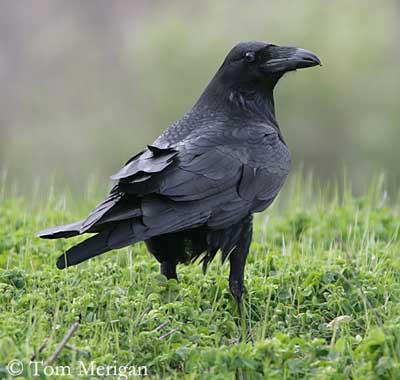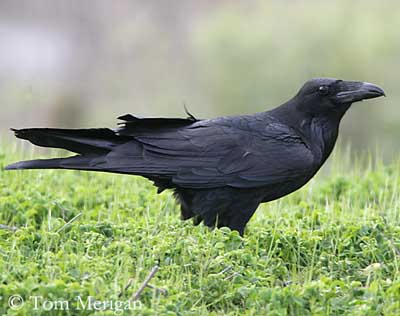
Common Raven
Corvus corax
Passeriforme Order – Corvidae Family
BIOMETRICS:
Length: 58-69 cm
Wingspan: 116-118 cm
Weight: 690-2000 g
DESCRIPTION:
Ravens have often played important roles in cultures, mythologies and writings, being alternately the eyes and ears of Odin in Scandinavia myths, the creator of human beings, but often a culture hero figure.
Now, they are protected and populations in North America and Europe are increasing, often at alarming rates, all across their range. Human developments provide them food, water and nest-sites.
This species is listed as Endangered by Kentucky and Tennessee.
Fr: Grand corbeau
All : Kolkrabe
Esp : Cuervo Grande
Ital: Corvo imperiale
Nd: Raaf
Russe: Ворон
Sd: Korp
Photographers:
Aurélien Audevard
OUESSANT DIGISCOPING
Didier Buysse
Vision d’Oiseaux
Tom Grey
Tom Grey's Bird Pictures
Tom Merigan
Tom Merigan’s Photo Galleries
Nicole Bouglouan
PHOTOGRAPHIC RAMBLE
Texte de Nicole Bouglouan
Sources:
HANDBOOK OF THE BIRDS OF THE WORLD Vol 14 by Josep del Hoyo-Andrew Elliot-David Christie - Lynx Edicions –
ISBN: 9788496553507
THE HANDBOOK OF BIRD IDENTIFICATION FOR EUROPE AND THE WESTERN PALEARCTIC by Mark Beaman, Steve Madge - C.Helm - ISBN: 0713639601
THE COMPLETE BOOK OF BRITISH BIRDS – Written by “Royal Society for the Protection of Birds” experts - Préface de Magnus Magnusson - Michael Cady- Rob Hume Editors - ISBN: 0749509112
L’ENCYCLOPEDIE MONDIALE DES OISEAUX - Dr Christopher M. Perrins - BORDAS - ISBN: 2040185607
BIRDS OF THE GREAT BASIN – by Fred A. Ryser - Univ of Nevada Pr -ISBN: 0874170796
Pájaros de España (JL Beamonte)
Wikipedia (Wikipedia, The Free Encyclopedia)
All About Birds (Cornell Lab of Ornithology)

Common Raven has glossy black plumage, with blue-purple iridescent feathers. Male shows elongated shaggy feathers on throat. They are rounded, as a semicircular fan. They are used in social communication, and especially during the dominance displays.
It has long pointed wings. Primaries are obviously separated when it soars. Tail is wedge-shaped and often slightly fanned. It is a large Raven.
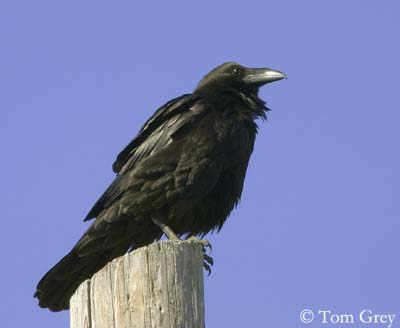
It has robust long black beak, slightly curved. Its bill is heavier than crow’s beaks, and it is covered with hard nasal bristles at the base of upper mandible.
Eyes are dark brown, almost black. Feet and short legs are black.
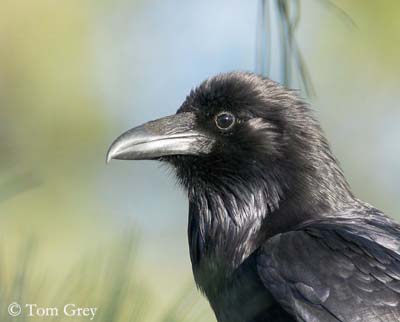
Sexes are similar in plumage, but male is slightly larger than female.
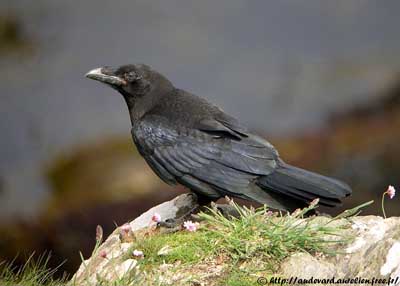
Several races are recognized. They differ mainly in size and iridescence colours in plumage.
VOICE: SOUNDS BY XENO-CANTO
Common Raven is very vocal. According to different purposes and social contexts, it utters varied series of calls and non-vocal sounds. It may utter from 15 to 30 types of vocalizations.
Usual calls are alarm calls, chase calls, and others to defend territory. Calls are high-pitched and raucous “praaak-praaak” in flight.
They are able to mimic other animals’ sounds, but they only can utter a wide diversity of calls, and create sounds resembling other species’ calls.
Common call is a deep “croak” or a hoarse “rrronk”, and a knocking “tok-tok-tok”.
Non-vocal sounds are wing whistles and bill snapping. (Boarman and Heinrich, 1999).
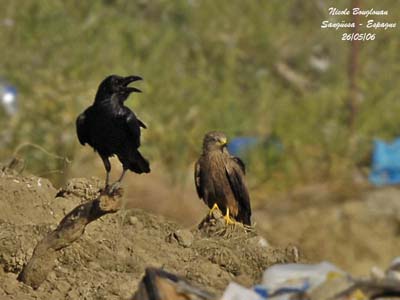
HABITAT:
Common Raven lives in various “wild” habitats, from coastal cliffs to high mountains. We also find them in open woodlands and forests, even in low areas. They nest in cliffs areas, but they are found in tundra and boreal forest, and also in urban areas.
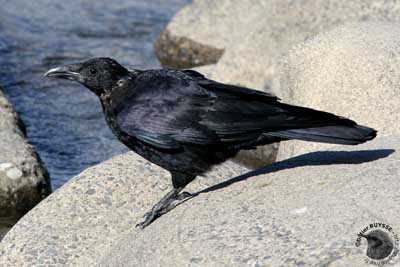
RANGE:
Common Raven is resident in its range. It lives in the Northern Hemisphere, in North America except in south eastern part, Asia, Northern Africa and Europe. It is one of the most widespread in the world.
BEHAVIOUR:
Common Raven is attracted to carrion, and insects found on this carrion. It also eats afterbirth of ewes and large mammals. It takes its food from the ground. It may store all kinds of food.
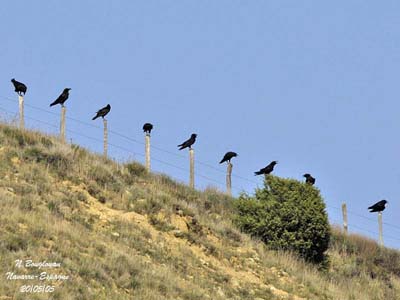
They are rarely seen hunting, even eggs or chicks at nest. They forage in large flocks in areas where food resources are abundant.
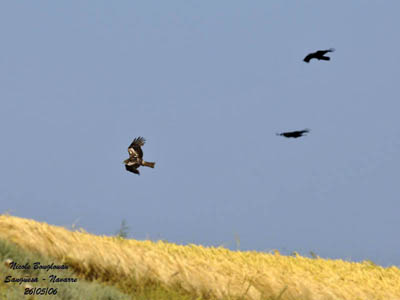
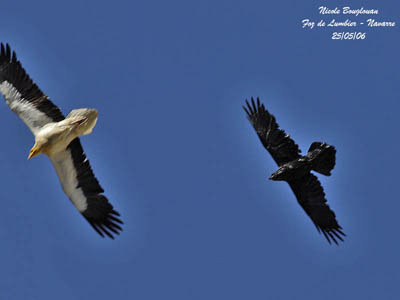
Common Raven defends strongly its young, chasing predators away while calling. But adults are wary when they approach new carrion, and they prefer to wait that no danger is around.
They form loose flocks during the day, and gather in large numbers for roosting at night. They are seen in pairs or small groups.
Common Raven communicates by vocalizations, but also by physical displays. Pair defending territory and nest site chases intruders for long distance, and may engage aerial fight.
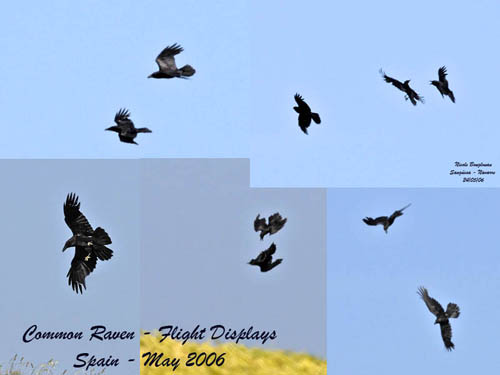
Common Raven is able to learn solutions to newly encountered problem. They do not migrate, but some seasonal movements are observed to avoid extreme weather. This smart species can survive in Arctic, as well as in desert or temperate environments.
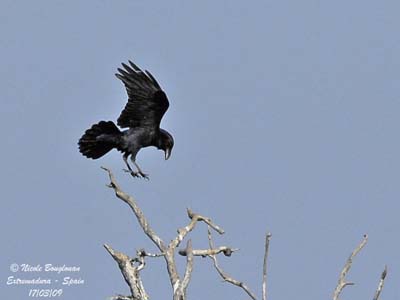
Courtship displays are poorly known. Displays seem to occur all year round, most intense in fall and winter, and include acrobatic flights.
Pairs stay together all the year and certainly for life. They are monogamous.
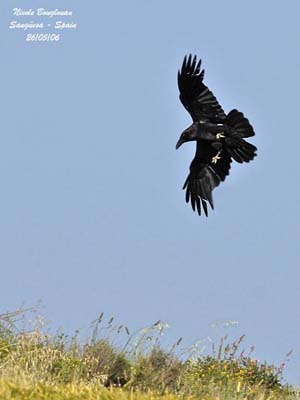
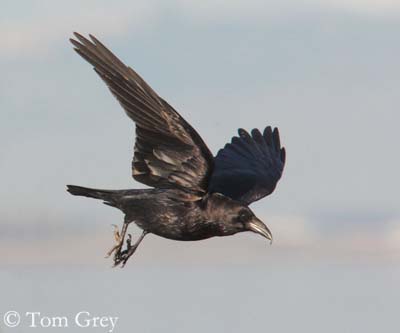
Courtship displays performed on the ground include bowing with elongated neck and fluffing throat feathers. Male has fanned wings and tail, stretching its neck upwards while is bowing with bill downwards. Sometimes it hops in the air, and performs preening on female’s head.
Female invites to copulation by crouching slightly and moving its wings (opening, extending or dropping) and shaking or quivering its raised tail.
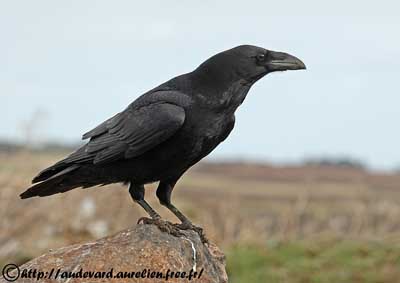
FLIGHT:
Common Raven has an agile and powerful flight. It also glides and soars on thermals at great heights. They may perform aerial fights and displays. Common Raven is an acrobatic flier, making rolls and elaborate movements in flight. It may fly upside down over one kilometre.
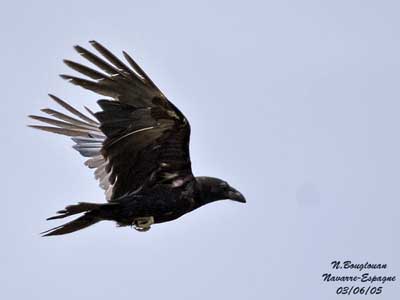
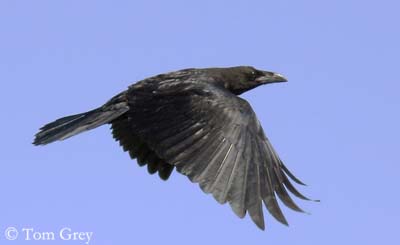
REPRODUCTION:
Common Raven nests in cliffs or in large trees, between 3 and 20 metres above the ground. The nest is a bulky basket made with sticks, reeds and decayed vegetable matter. The inner cup is made with twigs, and lined with soft materials, sheep’s wool, lichen, fur, grasses, mud and paper. Same nest is often re-used with new material added each spring.
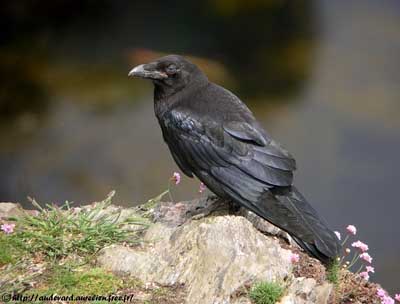
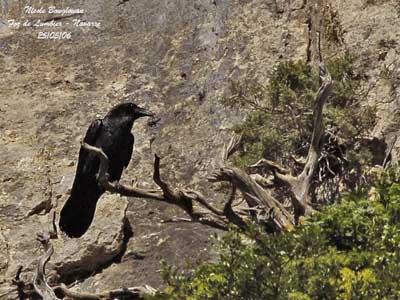
Female lays 3 to 7 pale bluish-green or olive-green eggs, blotched with dark olive-brown. Incubation lasts about 18 to 21 days, by female. She is fed by the male while she incubates. Chicks hatch altricial, with sparse down. They are fed by both parents, by regurgitated food and water stored in a throat pouch.
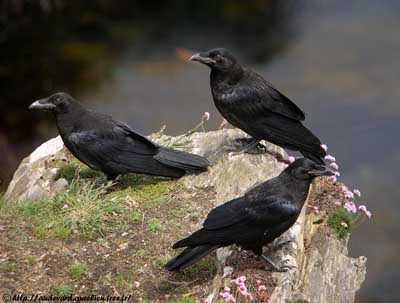
Young leave the nest between 5 and 7 weeks after hatching. They may leave the area and their family, or remain with their parents for a more extended period. They reach their sexual maturity at about three years.
This species produces only one brood per season.
DIET:
Common Raven feeds mainly on carrion. But it consumes arthropods, amphibians, small mammals, birds and reptiles. They also feed on vegetable food, such as grains, acorns, fruits and buds.
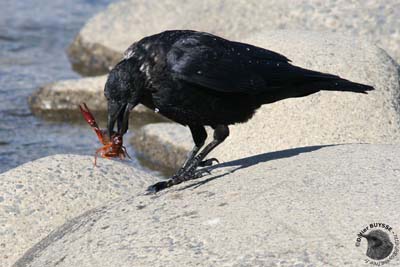
PROTECTION / THREATS / STATUS:
Common Raven has some predators such as hawks, eagles, other ravens, owls and martens. Other large raptors and coyote attack nest and fledglings.
Common Ravens have been persecuted by humans for preying on lambs and crops. They may be shot, poisoned or captured in traps, in order to protect other species.
